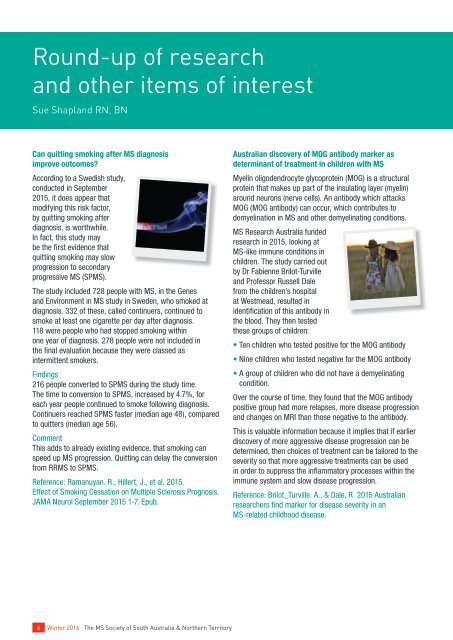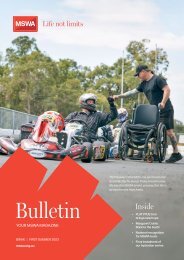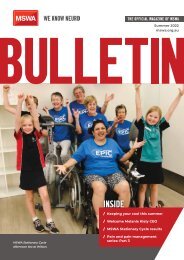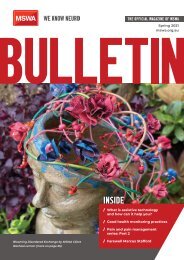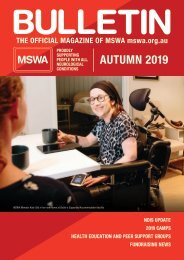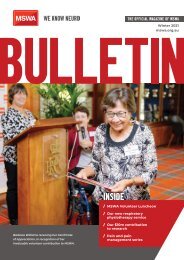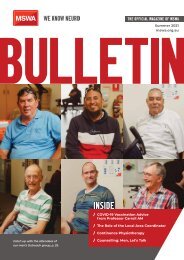MSSANT Network Magazine Winter 16
You also want an ePaper? Increase the reach of your titles
YUMPU automatically turns print PDFs into web optimized ePapers that Google loves.
Round-up of research<br />
and other items of interest<br />
Sue Shapland RN, BN<br />
Can quitting smoking after MS diagnosis<br />
improve outcomes?<br />
According to a Swedish study,<br />
conducted in September<br />
2015, it does appear that<br />
modifying this risk factor,<br />
by quitting smoking after<br />
diagnosis, is worthwhile.<br />
In fact, this study may<br />
be the first evidence that<br />
quitting smoking may slow<br />
progression to secondary<br />
progressive MS (SPMS).<br />
The study included 728 people with MS, in the Genes<br />
and Environment in MS study in Sweden, who smoked at<br />
diagnosis. 332 of these, called continuers, continued to<br />
smoke at least one cigarette per day after diagnosis.<br />
118 were people who had stopped smoking within<br />
one year of diagnosis. 278 people were not included in<br />
the final evaluation because they were classed as<br />
intermittent smokers.<br />
Findings<br />
2<strong>16</strong> people converted to SPMS during the study time.<br />
The time to conversion to SPMS, increased by 4.7%, for<br />
each year people continued to smoke following diagnosis.<br />
Continuers reached SPMS faster (median age 48), compared<br />
to quitters (median age 56).<br />
Comment<br />
This adds to already existing evidence, that smoking can<br />
speed up MS progression. Quitting can delay the conversion<br />
from RRMS to SPMS.<br />
Reference: Ramanuyan. R., Hillert, J., et al. 2015.<br />
Effect of Smoking Cessation on Multiple Sclerosis Prognosis.<br />
JAMA Neurol September 2015 1-7. Epub.<br />
Australian discovery of MOG antibody marker as<br />
determinant of treatment in children with MS<br />
Myelin oligodendrocyte glycoprotein (MOG) is a structural<br />
protein that makes up part of the insulating layer (myelin)<br />
around neurons (nerve cells). An antibody which attacks<br />
MOG (MOG antibody) can occur, which contributes to<br />
demyelination in MS and other demyelinating conditions.<br />
MS Research Australia funded<br />
research in 2015, looking at<br />
MS-like immune conditions in<br />
children. The study carried out<br />
by Dr Fabienne Brilot-Turville<br />
and Professor Russell Dale<br />
from the children’s hospital<br />
at Westmead, resulted in<br />
identification of this antibody in<br />
the blood. They then tested<br />
these groups of children:<br />
• Ten children who tested positive for the MOG antibody<br />
• Nine children who tested negative for the MOG antibody<br />
• A group of children who did not have a demyelinating<br />
condition.<br />
Over the course of time, they found that the MOG antibody<br />
positive group had more relapses, more disease progression<br />
and changes on MRI than those negative to the antibody.<br />
This is valuable information because it implies that if earlier<br />
discovery of more aggressive disease progression can be<br />
determined, then choices of treatment can be tailored to the<br />
severity so that more aggressive treatments can be used<br />
in order to suppress the inflammatory processes within the<br />
immune system and slow disease progression.<br />
Reference: Brilot_Turville. A., & Dale, R. 2015 Australian<br />
researchers find marker for disease severity in an<br />
MS-related childhood disease.<br />
From the UK MS Trust Website<br />
Drugs in development:<br />
Anti-LINGO – an experimental<br />
drug, given as an infusion<br />
or subcutaneous injection<br />
every two to four weeks,<br />
to promote remyelination of<br />
nerve cells. It is thought to<br />
promote the development of<br />
oligodendrocytes, the cells which<br />
maintain the myelin coating<br />
around nerves.<br />
A protein called LINGO-1, occurring only in the central<br />
nervous system, prevents the development of young cells<br />
into oligodendrocytes. Oligodendrocytes are the myelinating<br />
cells of the central nervous system (CNS).<br />
Anti-LINGO-1 has been found to block the action of LINGO-1,<br />
allowing young cells to mature into oligodendrocytes. This<br />
may restore repair of damaged myelin, offering the potential<br />
for preventing or possibly reversing disability.<br />
In a phase II study of people diagnosed with optic neuritis,<br />
anti-LINGO-1 treatment resulted in a small but significant<br />
improvement in transmission of nerve impulses via the<br />
optic nerve.<br />
No significant side effects have been seen in early<br />
clinical studies.<br />
An additional phase II study is under way, with 419<br />
participants with RRMS or SPMS taking Avonex (interferon<br />
beta 1a) once a week in combination with different doses of<br />
anti-LINGO-1 or placebo by intravenous infusion every four<br />
weeks. This study is due for completion in June 20<strong>16</strong>.<br />
Ocrelizumab is an experimental drug being tested as a<br />
treatment for RRMS and PPMS; taken as an intravenous<br />
infusion every six months.<br />
Ocrelizumab is a monoclonal antibody, a type of drug<br />
developed to attack specific targets in the immune system.<br />
• In RRMS, ocrelizumab reduced relapse rates by<br />
approximately 50% compared to beta interferon<br />
• In PPMS, ocrelizumab reduced 12-week disability<br />
progression by 24% compared to placebo<br />
BIOTIN (MD1003) is in phase III trials. A highly concentrated<br />
formulation of biotin is under investigation for SPMS and<br />
PPMS; it is taken as a capsule, three times a day.<br />
Also known as vitamin H or coenzyme R, biotin is one of<br />
the B-group vitamins (vitamin B7). It is necessary for cell<br />
growth, the production of fatty acids, and the metabolism<br />
of fats and amino acids, the building blocks of proteins.<br />
At the cellular level, it activates enzymes involved in energy<br />
production and synthesis of myelin.<br />
MD1003 is a highly-concentrated formulation of biotin.<br />
The doses being used in clinical trials correspond to<br />
10,000 times the recommended daily intake of biotin.<br />
A small pilot study has provided initial evidence that high<br />
doses of biotin might have an impact on disability and<br />
progression. A phase III clinical trial showed some evidence<br />
of a small improvement in disability.<br />
Preliminary results of a phase III study were reported at a<br />
scientific meeting. Investigators recruited 144 people with<br />
SPMS or PPMS who were having increasing difficulty with<br />
walking and leg weakness.<br />
No significant side effects have been reported so far.<br />
The effect of rhythmic-cued<br />
motor imagery on walking,<br />
fatigue and quality of life in<br />
people with multiple sclerosis:<br />
A randomised controlled trial<br />
Motor imagery (MI) is a technique<br />
where somebody thinks about<br />
moving their body in a certain<br />
way without actually moving; a technique commonly<br />
used by athletes to rehearse movements and skills to<br />
improve performance.<br />
This study investigated the use of MI in people with MS,<br />
combined with music with a strong beat or metronome,<br />
to see if walking could be improved. 101 participants,<br />
in three test groups received MI training session CDs and<br />
were told to practice for 17 minutes a day, six days a week<br />
for four weeks.<br />
continued overleaf<br />
6 <strong>Winter</strong> 20<strong>16</strong> The MS Society of South Australia & Northern Territory The MS Society of South Australia & Northern Territory <strong>Winter</strong> 20<strong>16</strong> 7


